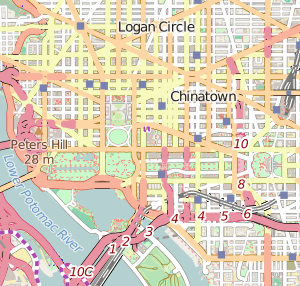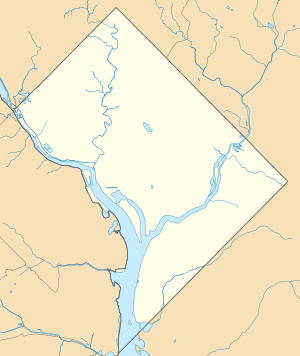Union Trust Building (Washington, D.C.)
|
Union Trust Building | |
|
| |
   | |
| Location | 740 15th Street, N.W., Washington, D. C. |
|---|---|
| Coordinates | 38°53′59″N 77°2′2″W / 38.89972°N 77.03389°WCoordinates: 38°53′59″N 77°2′2″W / 38.89972°N 77.03389°W |
| Architectural style | Neoclassical |
| NRHP Reference # | 84000867 [1] |
The Union Trust Building is a historic building, located at 740 15th Street, Northwest, Washington, D.C.
The building is listed on the National Register of Historic Places, and is a contributing property to the 15th Street Financial Historic District. It was listed on the National Register of Historic Places.
In 1906 Waddy Butler Wood and the Wood, Donn & Deming became the first Washington, D.C. architectural firm to design a bank high-risein their city when they designed the Union Trust Building, now home to the New America Foundation and Joe's, the DC location of a high end steak and seafood chain. The building is also listed on the National Register of Historic Places. In the past, the city's largest banks had each retained nationally renowned architects while local architects were only chosen to design bank branches or remodel existing buildings. By choosing Wood's firm, Union Trust began a trend of the city's banks choosing local architects to design their buildings.
Wood's partnership with Donn and Deming is best known for the firm's work in 1907 on the Masonic temple located at the intersection of 13th Street, H Street, and New York Avenue NW, which is now the National Museum of Women in the Arts. The 69,000-square-foot (6,400 m2) building, a specimen of neo-Renaissance and Renaissance Revival styles, was declared a Washington, D.C. Historic Landmark in 1984 and added to the National Register of Historic Places in 1987.
In addition to the Masonic lodge hall, the building originally housed professional offices, the George Washington University law library, and a movie theater. The exterior has never been altered substantially. As the Temple Association envisioned, the building's location at the tip of a wedge-shaped block provides an aesthetic buffer zone which "permits of no future building being erected sufficiently near to mar [the Temple's] monumental effect ... ."
See also
References
- ↑ National Park Service (2010-07-09). "National Register Information System". National Register of Historic Places. National Park Service.
External links
- http://www.ebay.com/itm/1920-Vintage-Ad-WASHINGTON-DC-Union-Trust-Building-PHOT-/310120436234
- http://www.flickr.com/photos/wallyg/5183588172/
- http://wikimapia.org/13612997/Union-Trust-Building